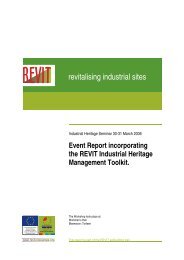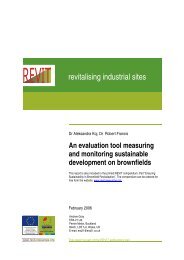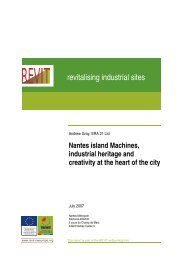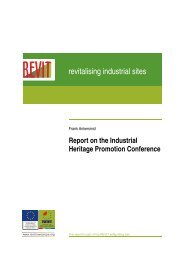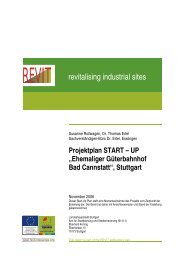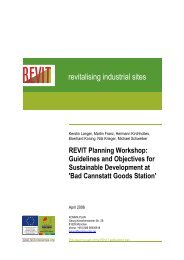REVIT Heritage Report.pdf
REVIT Heritage Report.pdf
REVIT Heritage Report.pdf
Create successful ePaper yourself
Turn your PDF publications into a flip-book with our unique Google optimized e-Paper software.
Torfaen County Borough Council<br />
<strong>REVIT</strong>: A Review of the Conservation of Industrial <strong>Heritage</strong> Assets on Brownfield Sites<br />
3.7.15 The main cultural heritage legislation is provided by the Historic Monuments<br />
Act of 1913; the Act of 1941 regulating archaeological excavations; and the Act<br />
of 1983 which decentralised certain planning and heritage functions and<br />
transferred Town Planning and development to the communes.<br />
3.7.16 The Archaeological Excavations Act (Act of 1941) makes archaeological<br />
excavations subject to state supervision and requires a permission to proceed<br />
with archaeological excavation.<br />
3.7.17 The Historic Monuments Act of 1913 provides protection of the cultural<br />
heritage at two levels:<br />
3.7.18 Listed buildings are protected as those buildings whose conservation is in the<br />
public interest, from a historic or artistic point of view, as well megalithic<br />
monuments and land which encloses prehistoric settlements or deposits. Such<br />
sites are listed on the recommendation of Historic Monuments Board<br />
(Commission supérieure des monuments historiques or CSMH); and<br />
3.7.19 Supplementary Inventory protects historic buildings and monuments which are<br />
of sufficient artistic or historical interest to justify their preservation. They are<br />
proposed by the Regional <strong>Heritage</strong> and Sites Board (CRPS).<br />
3.7.20 An Act of 1943 introduced the concept of the "setting" of a listed monument,<br />
defined as a 500 m radius around the monument. Once a building has been<br />
listed or included in the Supplementary Inventory all property, whether<br />
developed or not, the setting within a 500m radius of the monument and within<br />
sight of the monument is protected. Any building situated in the surroundings<br />
of a historic monument and in its field of view is deemed to be included in the<br />
supplementary inventory.<br />
3.7.21 A large part of France's rural heritage is in fact protected by the Supplementary<br />
Inventory; this protection is weak but has been effective in protecting villages<br />
and rural buildings. The weakness of the protection is supplemented by Urban<br />
Landscape <strong>Heritage</strong> Protection Zones (Zones de protection du patrimoine<br />
architectural, urbain et paysager or ZPPAUP) which are considered useful for<br />
protecting the heritage in rural areas.<br />
3.7.22 Under the decentralisation Act of 1983 each commune can replace the fixed<br />
500m protection of with an Urban <strong>Heritage</strong> Protection Zone (ZPPAUP) which is<br />
decided jointly by the commune and the state. Each ZPPAUP may take in the<br />
distinctive urban, archaeological, architectural and landscape features of one<br />
or more communes. These zones have made the rules governing the areas<br />
surrounding historical monuments more flexible, strengthened the protection of<br />
the urban and rural heritage and given communes an active role in managing<br />
and enhancing their heritage.<br />
3.7.23 A further Act of 1962 instituted the protection of conservation areas called<br />
areas of Safeguarded Sectors and Development (Plan de sauvegarde et de<br />
mise en valeur - PSMV), which are areas which have "a historical or aesthetic<br />
character likely to justify the conservation, restoration and development of<br />
whole or part of the whole of buildings”.<br />
3.7.24 The PSMV lays down design guidance for development proposals of every<br />
building and area within the zone e.g conservation, demolition, reconstruction,<br />
and protection of yards and gardens. The PSMV supersedes other Land Use<br />
Plans and any other town-planning documents in the area concerned. The<br />
PSMV, therefore, constitutes both a conservation area and acts as a town<br />
planning document.<br />
0014021/JM/001 12




